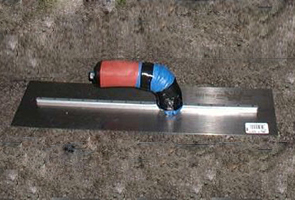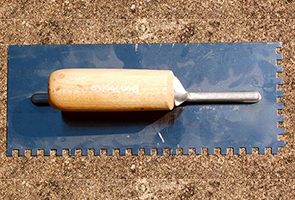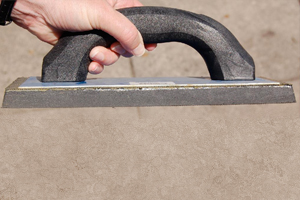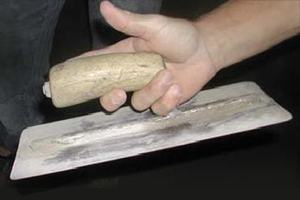You may be able to modify or replace the grip:
If the handle grip size is too small for your hand, you can apply a tool sleeve or use a padding kit, such as the ViscolasOrthex™ Grip Kit*, to increase the size of the handle grip. Wearing gloves may also help since they typically reduce your effective grip size. Depending on the materials and products you are working with a specific type of glove may be recommended or required to protect your hands from skin disorders, such as burns and dermatitis, or other injuries. Note: some workers have reported a reduced sense of touch and needing a stronger grip to hold on to tools when wearing gloves. Using a hand tool with a non-slip grip area or adding an anti-slip material may help.
If your palm size is too big and the tool handle is digging into your palm, you may be able to:
 If you grip your flat trowel from the stem you can also use padding to create a cushion that will reduce the pressure on your palm and change the angle between the handle and stem to position your wrist in a more comfortable and less hazardous position (photo 4).
If you grip your flat trowel from the stem you can also use padding to create a cushion that will reduce the pressure on your palm and change the angle between the handle and stem to position your wrist in a more comfortable and less hazardous position (photo 4).
If you already have a hand/arm injury or condition such as tendonitis, arthritis, or carpal tunnel syndrome, the smallest, lightest weight trowel or float for the job is best.
Example:
Worker Hand Measurements = hand size (length) of about 7-1/2" (or 7.5"), with a grip diameter of about 1-1/2" (or 1.5"), a grip size of about 4-7/10" (or 4.7"), and a palm size of 3".
Choices:
11" x 4-3/4" Flat Trowel with wood handle, 5-3/8" (or 5.375") grip at its widest point, a 4-1/2" handle length in wood, and a total weight of 12.9 oz.
OR
11" x 3-3/8" Flat Trowel with wood handle, 5-1/8" (or 5.125") grip at its widest point, a 4-1/2" handle length in wood, and a total weight of 12.5 oz.
What the worker in this example should consider:
- Both of these trowels have handle lengths that are large enough for this worker's hand size, but the grip sizes are too big. If the handles can be replaced or modified as noted above, and if both size flat trowels will work for the job being performed, the lighter one will help reduce the worker’s fatigue and risk of injury.





 If you grip your flat trowel from the stem you can also use padding to create a cushion that will reduce the pressure on your palm and change the angle between the handle and stem to position your wrist in a more comfortable and less hazardous position (photo 4).
If you grip your flat trowel from the stem you can also use padding to create a cushion that will reduce the pressure on your palm and change the angle between the handle and stem to position your wrist in a more comfortable and less hazardous position (photo 4).